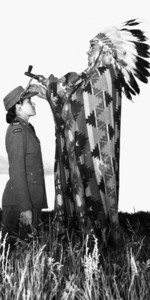Mary Greyeyes
| Surname | Greyeyes |
| Given Name | Mary |
| Country | Canada |
| Category | Military-Ground |
| Gender | Female |
Contributor: C. Peter Chen
ww2dbaseMary Greyeyes was born into the Native American Meskeg Lake Cree Nation in Saskatchewan, Canada in 1920. In Jun 1942, following the footsteps of her brother who had already enlisted in military service, she traveled to Saskatoon to enlist as well. As the sergeant told her of her acceptance, she became the first Native American woman to join the Canadian armed forces as a member of the Canadian Women's Army Corps. Although she was the subject of a famous photograph meant to increase recruitment into the military, she would find that she was discriminated against by fellow Canadians, barred from regular barracks and constrained to menial jobs such as laundering or cooking, due to her ethnicity.
ww2dbaseIn late Jun 1942, within the first month of her military career, several men from the Royal Canadian Mounted Police visited the Piapot reserve, looking to stage a propaganda photograph with Greyeyes. They ran into WW1 veteran and councilor Harry Ball, who agreed to partake in this effort in exchange of 20 dollars. Pieces of clothing and accessories that might contain Native American flare were borrowed from nearby homes to make Ball appear to be a chief or someone of importance. The resulting photograph, depicting a Native American chief bestowing blessing upon the patriotic and uniformed Greyeyes, quickly became a famous photograph in Canada after first being published in the Regina Leader-Post. Quickly, the photograph was published all across the British Empire. Somewhere along the way, it gained the official caption of "Unidentified Indian princess getting blessing from her chief and father to go fight in the war". It would be many decades before Melanie Fahlman Reid, Greyeyes' daughter-in-law, could successfully persuade Library and Archives Canada to include Greyeyes' name in the caption; LAC's current caption for the photograph would still contain the "chief" description, however.
ww2dbaseDespite the newly gained fame, Greyeyes was kept in menial positions. She was shipped out to southern England, United Kingdom to wash laundry and then to cook. As one of the few Native Americans in service in the region, she was often brought to events where diversity was needed, thus she was often seen in newspapers, and she was given the opportunity to meet the Queen Mother, King George VI, and Princess Elizabeth.
ww2dbaseAfter the war, Greyeyes returned to Canada in 1946. She passed away in 2011. She was also known by her post-marriage last name of Greyeyes-Reid.
ww2dbaseSources:
Melanie Fahlman Reid, "What Does This Photo Say?", "The Tyee", 7 Aug 2012
Wikipedia
Last Major Revision: Apr 2015
Photographs
 |
Did you enjoy this article or find this article helpful? If so, please consider supporting us on Patreon. Even $1 per month will go a long way! Thank you. Share this article with your friends: Stay updated with WW2DB: |
Visitor Submitted Comments
All visitor submitted comments are opinions of those making the submissions and do not reflect views of WW2DB.
- » Wreck of USS Edsall Found (14 Nov 2024)
- » Autumn 2024 Fundraiser (7 Nov 2024)
- » Nobel Peace Prize for the Atomic Bomb Survivors Organization (11 Oct 2024)
- » Wreck of USS Stewart/DD-224 Found (2 Oct 2024)
- » See all news
- » 1,150 biographies
- » 337 events
- » 43,917 timeline entries
- » 1,241 ships
- » 350 aircraft models
- » 207 vehicle models
- » 374 weapon models
- » 123 historical documents
- » 260 facilities
- » 470 book reviews
- » 28,543 photos
- » 432 maps
Winston Churchill
Please consider supporting us on Patreon. Even $1 a month will go a long way. Thank you!
Or, please support us by purchasing some WW2DB merchandise at TeeSpring, Thank you!
15 Apr 2015 01:57:07 PM
Mary Greyeyes was, unfortunately, also a woman. Women were, in general,discriminated against by fellow Canadians,barred from some places, paid less than men doing the same skilled job and often constrained to menial jobs because of their gender. I admire and respect Mary Greyeyes for sticking it out despite this and ALSO for the extra difficulties she may have pencountered because she was a native woman in the military.